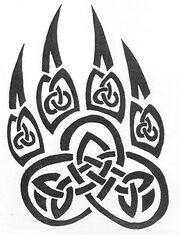
A symbol of the Chieftain of Locudula, one of the more powerful chieftains
The Chiefdoms and Chieftains of Keltoia (Known natively as the Walosalvdems and the Walosalvs, respectively) were powerful agents and a vital part of the government of Keltoia. Created during the phenomenon of Ambactoismos, these semi independent states and their leaders would define the history of Keltoia. These leaders were generally be similar the the Emperor, but on a smaller scale. For example, they had a substantial amount of economic control over their Chiefdoms, and have a fair amount of say over the army. However, like the Emperor's position, they would often have to fight for their sovereignty and their powers, at least politically. In fact, their constant jockeying for power would often be detrimental to the Empire's stability.
The chiefdoms, despite all the political maneuvering, were designed to do one thing - keep the empire stable. In fact, the initial creation of them had been intended to do just that. Welcrew had been losing control of his empire due to rebellion and disedence, but was able to establish some level of control. In addition to keeping the empire stable, the decision to give the chieftains the powers they had was rationalized by the idea that it was better for local leaders to rule if the empire wanted to remain stable. However, these two designations were often ignored. Chieftains often tried to grab power, and over time generally became more of a destabilizing influence than a stabilizing one.
Composition[]
Officially, there were seven chiefdom than made up Keltoia - Keltoia, Celturca, Dulsor, Kelsart, Locudula, Mediterranean and South Keltoia. However for most practical purposes there were only six; Keltoia was usually ignored, as its chieftain was intentionally the Emperor. Each Chiefdom had one chieftain, as well as any aids, diplomats, or other court members the Chieftain saw fit. The Chieftains were almost exclusively male, though there is record of several female chieftains, though these were generally weak rulers, serving as puppets to either of chieftains or the Emperor. In general, succession was decided in the same manner as the Emperor's secession, with the current chieftain making a list of those he wished to follow him and updating the list throughout his life.
Influence and Power[]
The Chieftains wielded a similar set of powers to those of the emperor, just on a smaller scale with more oversight. For example, while the Emperor could allow merchants to access the whole empire, Cheiftains could allow merchants withing their own Chiefdom. The Chieftains also held substantial economic influence over their realms. They could set taxes and trade routes, ban certain items, or even put a price ceiling on various goods. This gave the Chieftains a compelling source of wealth, one which was often abused by the less wise cheiftains. In addition, the Chieftains could raise armies for strictly defensive purposes. However, most took a very liberal definition of "defensive." and the more aggressive cheiftains were known to launch attacks against Iberian or Germanic tribes.
Despite their expansive powers, it was hardly unknown for chieftains to come into conflict with one another - in fact, it generally happened to some extent at least every decade. Generally, these would just be competitions of sorts, but they could seriously harm the economies of the chieftains. Often, they would cut off trade routes to one another, and in the process often dragged more chieftains into the fray. However, despite the antagonism, the conflicts almost never devolved into full on war. For one, this would drag the Emperor in, who obviously had the largest army, and for another, it would almost certainly destroy their chiefdom. So, a a result, most of the chieftains were stuck with their somewhat limited set of powers, even as the scampered for any opportunity at new ones.
Duties[]
While they vied for power, Chieftains did have a set of responsibilities to uphold, for both their citizens and the emperor. The first item on this list was the maintenance of roads, cities, and other infrastructure. Not only was this required to support trade, but it was considered beneath the Emperor to do the same management (Incidentally, this meant the Chieftain of Locudula was responsible for the infrastructure of Keltoia). Their other main responsibility was funding and maintaining a military. They couldn't use the troops of course, instead they simply kept them on hand for a time when they were needed by the Emperor or for defense.
| |||||||||||||||||||||||||||||||

